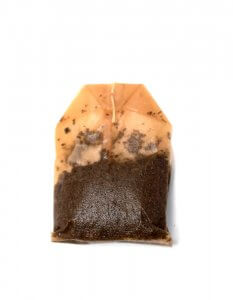First thing after your tooth extraction surgery, you will most certainly have some bleeding. And, that's normal. In fact, to help, your dentist will put gauze, or dressing, over the socket. But how do you know how long to keep gauze in after tooth extraction?

In our guide below, we'll dive into:
- How long you should keep the dressing in place to help the blood clot form
- How often you should swap it out for new gauze
- When it may be time to call your dentist
- Other ways you can help stop the bleeding
We hope this helps take some of the uncertainty out of the experience as you recover from extraction surgery.
In This Article
How long will I bleed after a tooth extraction?
It's perfectly normal to bleed after your surgery. After all, you have just had a tooth removed, leaving a hole in its place. The good news is that the bleeding generally doesn't last very long. It typically lasts an hour or two, and maybe a bit more in some cases.
Right after the procedure, your dentist will place gauze over the site and apply pressure. This helps stop the bleeding. You should try to keep that pressure on the wound for as long as the dressing is in place.

How long do you have to wear gauze after a tooth extraction?
You will likely only be using gauze for several hours after your surgery.
Keeping it on the hole after your surgery will help to absorb the blood, but the real goal is to apply pressure. You want to bite your teeth together so that the wound has pressure directly on it.
As long as the area is bleeding or oozing, you should leave the dressing in place. That's typically about one hour.
After one hour, you should gently take the gauze out and check the socket to see how it's doing. If it continues to ooze, then you will want to get a new gauze dressing and place it into your mouth. It's a good idea to do this and reevaluate each hour until you don't need it anymore.
When you do remove the dressing, check any blood that it has absorbed. If it's pretty wet with saliva and has a mostly pinkish color to it, then you're likely almost done with it.
However, if it's still red and saturated, it's possible you haven't been applying enough pressure.
If that is the case, you should apply a new piece of gauze and make sure to bite down to apply enough pressure on the hole for a while longer.
When to change gauze after tooth removal
As mentioned above, as you routinely check on the dressing each hour after surgery, you should switch out the gauze each time until you no longer need it. Don't put a dirty dressing back on the socket.
Make sure you wait that hour before changing it because if you remove it too much and too often, it could actually cause the clot to dislodge.
If it were to dislodge, that would expose the nerves and bone in the site. This can lead to an infection or dry socket and, ultimately, your healing time will be much longer. Dry socket is the most common complication of tooth removal and can be incredibly painful.
Apart from routine checking, you should remove the dressing whenever you eat or drink and replace it with a fresh one when you have finished.
It's also important to consume only soft foods at first and avoid using a straw as well as smoking.

Additional ways to stop the bleeding
By applying a good amount of pressure on the dressing, you should be able to stop the bleeding.
However, if you are unable to get the bleeding to end following your dental surgery, there are other things you could give a try.
For example, you could try taking a wet, black tea bag and place it on the hole. The bag's tannic acid can actually help give a blood clot a better chance to form. Once it does form, the bleeding will let up.
When to call your dentist
If you feel a lot of pain and bleeding that you can't get to stop, you should contact your dentist. While seeing red discharge post-surgery is common, you should not need to use any dressing to cover the hole the day after surgery.
Also, if you notice that you haven't been clotting or the clot has become dislodged, you will want to contact your dentist because you could be at risk for dry socket. In order to prevent infection, it's possible that your dentist will recommend that you take a medication like antibiotics.

Conclusion
It's best to have gauze over the extraction site after your tooth extraction, but it's also important to be sure that you follow all of your dentist's instructions. This will include:
- Taking any prescribed antibiotics
- Avoiding sucking motions, like smoking and drinking through a straw
- Eating soft foods to help your healing process
- Avoiding alcohol
- Keeping the area clean
By keeping the dressing in place, applying pressure to it, and changing it every hour, it shouldn't be long before the wound starts clotting. This will help you get back to normal while still avoiding infection or dry socket.
If you feel pain, the clot doesn't form, or the socket starts bleeding again several hours after the surgery, it's best to reach out to your dentist.




